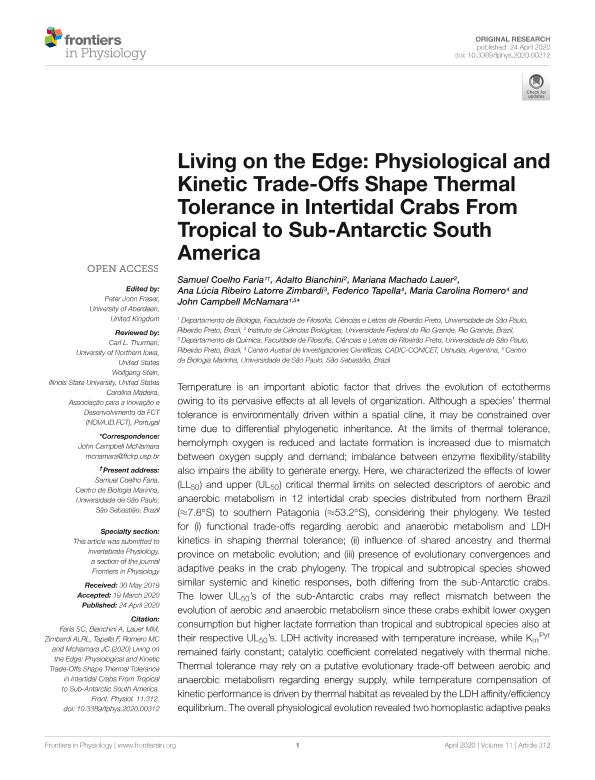Mostrar el registro sencillo del ítem
dc.contributor.author
Coelho Faria, Samuel
dc.contributor.author
Bianchini, Adalto
dc.contributor.author
Machado Lauer, Mariana
dc.contributor.author
Ribeiro Latorre Zimbardi, Ana Lúcia
dc.contributor.author
Tapella, Federico

dc.contributor.author
Romero, Maria Carolina

dc.contributor.author
Campbell McNamara, John
dc.date.available
2021-09-27T12:31:34Z
dc.date.issued
2020-04
dc.identifier.citation
Coelho Faria, Samuel; Bianchini, Adalto; Machado Lauer, Mariana; Ribeiro Latorre Zimbardi, Ana Lúcia; Tapella, Federico; et al.; Living on the Edge: Physiological and Kinetic Trade-Offs Shape Thermal Tolerance in Intertidal Crabs From Tropical to Sub-Antarctic South America; Frontiers Media S.A.; Frontiers in Physiology; 11; 4-2020; 1-15
dc.identifier.issn
1664-042X
dc.identifier.uri
http://hdl.handle.net/11336/141543
dc.description.abstract
Temperature is an important abiotic factor that drives the evolution of ectotherms owing to its pervasive effects at all levels of organization. Although a species’ thermal tolerance is environmentally driven within a spatial cline, it may be constrained over time due to differential phylogenetic inheritance. At the limits of thermal tolerance, hemolymph oxygen is reduced and lactate formation is increased due to mismatch between oxygen supply and demand; imbalance between enzyme flexibility/stability also impairs the ability to generate energy. Here, we characterized the effects of lower (LL50) and upper (UL50) critical thermal limits on selected descriptors of aerobic and anaerobic metabolism in 12 intertidal crab species distributed from northern Brazil (≈7.8°S) to southern Patagonia (≈53.2°S), considering their phylogeny. We tested for (i) functional trade-offs regarding aerobic and anaerobic metabolism and LDH kinetics in shaping thermal tolerance; (ii) influence of shared ancestry and thermal province on metabolic evolution; and (iii) presence of evolutionary convergences and adaptive peaks in the crab phylogeny. The tropical and subtropical species showed similar systemic and kinetic responses, both differing from the sub-Antarctic crabs. The lower UL50’s of the sub-Antarctic crabs may reflect mismatch between the evolution of aerobic and anaerobic metabolism since these crabs exhibit lower oxygen consumption but higher lactate formation than tropical and subtropical species also at their respective UL50’s. LDH activity increased with temperature increase, while KmPyr remained fairly constant; catalytic coefficient correlated negatively with thermal niche. Thermal tolerance may rely on a putative evolutionary trade-off between aerobic and anaerobic metabolism regarding energy supply, while temperature compensation of kinetic performance is driven by thermal habitat as revealed by the LDH affinity/efficiency equilibrium. The overall physiological evolution revealed two homoplastic adaptive peaks in the sub-Antarctic crabs with a further shift in the tropical/subtropical clade. The physiological traits at UL50 have evolved in a phylogenetic manner while all others were more plastic. Thus, shared inheritance and thermal environment have driven the crabs’ thermal tolerance and metabolic evolution, revealing physiological transformations that have arisen in both colder and warmer climes, especially at higher levels of biological organization and phylogenetic diversity.
dc.format
application/pdf
dc.language.iso
eng
dc.publisher
Frontiers Media S.A.

dc.rights
info:eu-repo/semantics/openAccess
dc.rights.uri
https://creativecommons.org/licenses/by-nc-sa/2.5/ar/
dc.subject
BRACHYURA
dc.subject
CRITICAL LIMITS
dc.subject
EVOLUTIONARY PHYSIOLOGY
dc.subject
LACTATE
dc.subject
LDH
dc.subject
OXYGEN CONSUMPTION
dc.subject
THERMAL ADAPTATION
dc.subject.classification
Biología Marina, Limnología

dc.subject.classification
Ciencias Biológicas

dc.subject.classification
CIENCIAS NATURALES Y EXACTAS

dc.title
Living on the Edge: Physiological and Kinetic Trade-Offs Shape Thermal Tolerance in Intertidal Crabs From Tropical to Sub-Antarctic South America
dc.type
info:eu-repo/semantics/article
dc.type
info:ar-repo/semantics/artículo
dc.type
info:eu-repo/semantics/publishedVersion
dc.date.updated
2021-08-27T20:48:38Z
dc.journal.volume
11
dc.journal.pagination
1-15
dc.journal.pais
Reino Unido

dc.description.fil
Fil: Coelho Faria, Samuel. Universidade de Sao Paulo; Brasil
dc.description.fil
Fil: Bianchini, Adalto. Universidade Federal Do Rio Grande.; Brasil
dc.description.fil
Fil: Machado Lauer, Mariana. Universidade Federal Do Rio Grande.; Brasil
dc.description.fil
Fil: Ribeiro Latorre Zimbardi, Ana Lúcia. Universidade de Sao Paulo; Brasil
dc.description.fil
Fil: Tapella, Federico. Consejo Nacional de Investigaciones Científicas y Técnicas. Centro Austral de Investigaciones Científicas; Argentina
dc.description.fil
Fil: Romero, Maria Carolina. Consejo Nacional de Investigaciones Científicas y Técnicas. Centro Austral de Investigaciones Científicas; Argentina
dc.description.fil
Fil: Campbell McNamara, John. Universidade de Sao Paulo; Brasil
dc.journal.title
Frontiers in Physiology
dc.relation.alternativeid
info:eu-repo/semantics/altIdentifier/url/https://www.frontiersin.org/article/10.3389/fphys.2020.00312/full
dc.relation.alternativeid
info:eu-repo/semantics/altIdentifier/doi/http://dx.doi.org/10.3389/fphys.2020.00312
Archivos asociados
